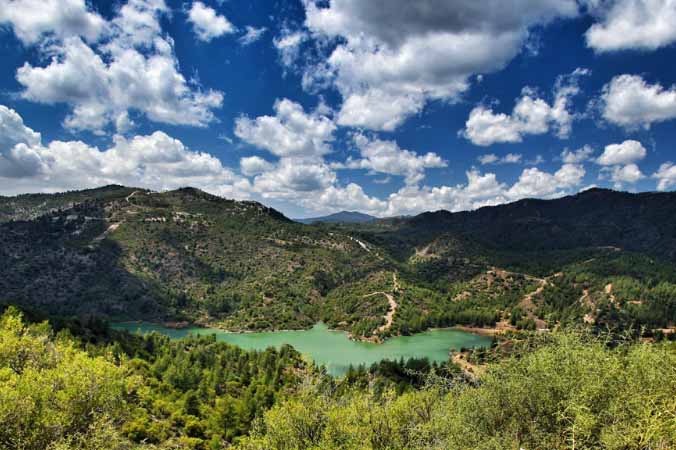About Cyprus
Cyprus [in Greek: Κύπρος – Kipros], officially the Republic of Cyprus is the third largest island in the Mediterranean, with a rich, turbulent history stretching back to antiquity. A story past 10,000 years long has seen civilizations come and go, from Alexander the Great to Queen Cleopatra of Egypt, who stake their claim here.
The island of beauty
Aphrodite, the Greek goddess of beauty and love was born here. According to Greek mythology, Aphrodite was born when Uranus, the father of the gods, was castrated by his son Cronus. The severed genitals where then thrown into the ocean which began to churn and foam. From the “aphros” (‘sea foam’) arose Aphrodite (hence her name, meaning ‘foam-arisen’) and the girl floated ashore on a scallop shell. This iconic representation of Aphrodite as a mature “Venus rising from the sea” (Venus Anadyomene) was made famous in a much-admired painting by Apelles, now lost, but described in the Natural History of Pliny the Elder. The theme persisted in art through the middle ages with universally recognised works of art like “The birth of Venus” by Botticelli.
A brief history
The history of Cyprus is one of the oldest recorded in the world and its historical significance is disproportionate to its small size. The earliest known human activity on the island dates back to the 10th millennium BC. Archaeological remains from this period include the well-preserved Neolithic village of Khirokitia. The arrival, in the 2nd millennium BC, of Mycenaean-Achaean Greeks as permanent settlers, introduced their language and culture to Cyprus, which though subsequently subjugated by various conquerors, retained its Greek identity.
Due its strategic location in the Middle East, Cyprus was subsequently occupied by several major powers, including the empires of the Assyrians, Egyptians and Persians, from whom the island was seized in 333 BC by Alexander the Great. Subsequent rule by Ptolemaic Egypt, the Classical and Eastern Roman Empire, Arab caliphates for a short period, the French Lusignan dynasty and the Venetians, was followed by over three centuries of Ottoman rule.
Cyprus was then placed under British administration in 1878 and formally annexed by Britain in 1914. Following nationalist violence in the 1950s, Cyprus was granted independence in 1960. On 15 July 1974, a coup d’état was staged; this action was followed by the Turkish invasion of Cyprus, which led to the capture of the northern part of Cyprus by Turkey. A separate Turkish-Cypriot state was declared in the occupied northern part of the island in 1983, a state recognised internationally only by Turkey. These events and the resulting political situation are matters of a continuing dispute.
On 1st May 2004, Cyprus became a full member of the European Union and on 1st January 2008 it joined the euro zone.



Cyprus today
Cyprus is a major tourist destination in the Mediterranean. With an advanced, high-income economy and a very high Human Development Index, Cyprus is a modern country that combines European culture with ancient enchantment. Having emerged as one of the region’s leading business and financial centers, the island enjoys competitive advantages in areas such as tourism, consultancy, shipping, telecommunications, banking, and insurance.
Cyprus is also endowed with golden beaches, virgin green forests and other natural wonders. In fact, Cyprus epitomizes the ideal weather of the Mediterranean region with sunshine and fine temperatures almost every day. Extremes of temperatures are rare, meaning Cyprus has something to offer every month of the year, whether it’s swimming, as late as November, or enjoying cultural sites and festivals all year long.
Gastronomy
The food of Cyprus reflects the rich and turbulent history of the island and its indelible Greek culture. You will find tastes influenced by the Middle East, Asia Minor and the Venetians, all using fresh local ingredients, herbs and spices and olive oil. The Mediterranean diet, with its grains and pulses, sun-ripened fresh fruit and vegetables, high-protein fish, lean meat and poultry and wine is a healthy option as well as an irresistible temptation.
Cyprus’ traditional cheese is maybe the most famous of all Cypriot products. ‘Halloumi’ is a firm, brined, slightly springy white cheese, traditionally made from a mixture of goat, sheep and cow milk. It has a distinctive salty flavour (imbibed from the brine preserve) but when cooked the saltiness goes away, giving the cheese a wonderful creamy texture.
Halloumi can be served fresh, offering its refreshing qualities and this is why it is often offered as an accompaniment with alcohol. Halloumi can also be cooked, as it has a high melting point. That’s why the most common Cypriot dish is simply… Grilled halloumi!
Halloumi is registered as a protected Cypriot product within the USA and the same procedure is currently underway with the European Union. When it will be registered as a PDO (Protected designation of origin), it will receive similar status as the other 600 European agricultural products, such as Feta and Parmesan cheese.
Commandaria is acknowledged to be the oldest wine in the world and is probably the first to be given an ‘Appellation d’ Origine’ (label of geographical origin). Commandaria depicting its geographical origin “Commandarie” which was the name given to the land owned by the Knights Templar and later the Knights of the Order of St. John. Legend says that Commandaria was originally made for Richard the Lionheart and its Crusaders. This delightful dessert wine, which has a taste not unlike sweet sherry, has been made using the same method for hundreds of years.
Zivania, one of Cyprus’s traditional alcoholic drinks, dates back to the end of the 14th century. It is considered as “a drink for the brave” as the alcohol content of this white spirit can range from 40% to 99%. It usually accompanies a good meal such as mezedes or is served chilled with dried fruit and nuts, and is best enjoyed in good company.
